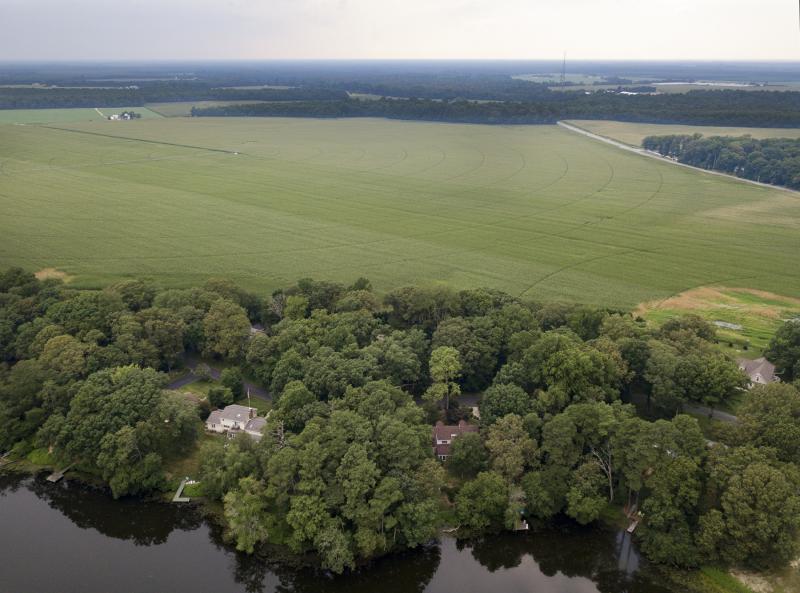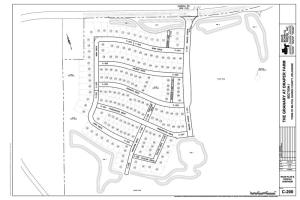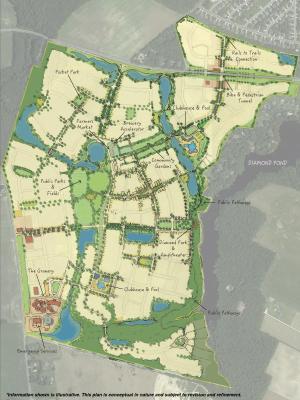Miltonians turn out for Granary workshop

A crowded Milton library meeting room was the scene Aug. 21 for Milton Town Council to hold a workshop on the proposed special development district for the Granary at Draper Farm project.
This was the second workshop meeting exclusively devoted to discussing the special development district and use of the funds being raised; a previous workshop was held in July. However, renewed interest through Milton-centric social media channels raised interest from citizens seeking answers to questions about how the development district would work and how the town would use the proposed $5 million it would get over the life of the project.
John Stalfort, attorney for developer Convergence Communities, addressed new faces in the audience by running down a history of how things got to this point. In August 2022, Convergence asked the town to consider the Granary as a special development district, a designation that was approved by council. Under a special development district, the town would issue bonds to help cover infrastructure-related costs for the development, and those costs would be paid back through a special tax levied on Granary property owners. Convergence would still be responsible for paying a performance bond, which would guarantee the streets and sidewalks are completed in the event Convergence became insolvent.
Convergence has agreed to pay the town $5 million raised by the special development district to do other infrastructure projects. However, the money comes with a number of strings attached: First, only projects built inside the Granary that benefit Granary residents would be covered 100 percent. Projects outside the Granary or located in the Granary but that benefit people outside the development would be covered 33 percent, with the town needing to cover the remaining costs. The town would also get the money in three tranches, with the first expected to come sometime in 2024, when the project is expected to break ground. Two remaining tranches would be released in 2030 and 2035; the Granary has an anticipated 20-year buildout that would add more than 1,300 units on a 450-acre parcel off Sand Hill Road. The town would have three years to spend the money, or else it would revert back to Convergence. The town’s full faith and credit would not be affected by the special development district. Stalfort said the bonds are tax-exempt and are backed by residents of the Granary and bond investors, not the town.
In previous meetings, the town council has gone from thinking big – projects such as a police station or public works facility – to smaller projects like new street lighting, road repair and restrooms in Memorial Park.
Colby Cox, Convergence founder, said, “The Granary at Draper Farm is a project unlike any other that I know of that has been annexed into the town.”
He touted the 55 acres of land that are proposed to be used as park land/open space, and said the waterfront along Diamond Pond will be dedicated as open space. The development also includes a trail that would run throughout the property and connect with the town’s Rails to Trails. Cox said 114 acres of the parcel are designated to remain as open space. The development is also planned to include an amphitheater and a mini-brewery.
“The only way that this level of infrastructure for public use can be funded is through an SDD,” Cox said. “This is completely outside the realm of a normal subdivision or community. The SDD can only fund public improvements. It cannot fund private improvements that I am making as the developer. I have to fund those. The money from the SDD is for those public improvement projects.”
Cox added that the town bears no cost for the implementation or management of the special development district, which will be managed by an independent third party chosen by the town.
Stalfort and Mayor John Collier then returned to the purpose of the workshop: establishing a list of potential projects for the first tranche of money.
Councilwoman Lee Revis-Plank raised a number of concerns about the proposal, stating that a special development district might not be the best use of revenue due the town, particularly on the administrative side. Stalfort said the administration of the SDD is paid for out of the SDD funds, with no costs coming out of the town’s end.
Cox said the majority of the expenses needed to build the community will be funded by Convergence, and the SDD funds will be exclusively used for public benefits.
“These are additional expenses beyond the realm of what it costs to develop a community,” Cox said.
Councilwoman Randi Meredith liked the idea behind the SDD as it would make the Granary more than just a typical development and would add additional park land to the town.
First section preliminary site plans approved
Meanwhile, by a unanimous vote Aug. 15, Milton Planning and Zoning Commission approved preliminary site plans for Section 1 of the Granary.
The approval comes with a series of conditions to be met before final approval is given. Those include a detailed lighting plan, additional detail in the street design and additional landscaping, particularly screening trees that could serve as a buffer to Sand Hill Road.
Section 1 of the Granary is planned for the northwest corner of the property off Sand Hill Road and would include 175 units. The ingress of Section 1 will come from Sand Hill Road onto the to-be-built Draper Drive, which would feed to access roads serving the interior lots.
With the preliminary approval, the public input portion for this phase is complete. Convergence Communities will now seek approvals from state and county agencies, and meet the commission’s conditions before coming back for final site-plan approval.



















































